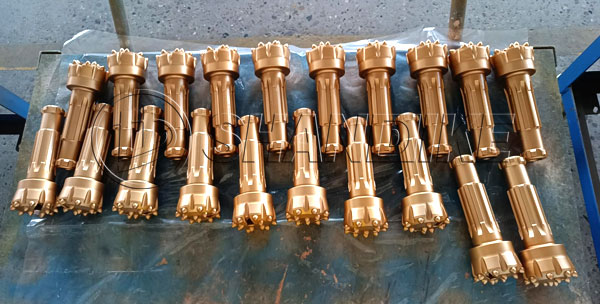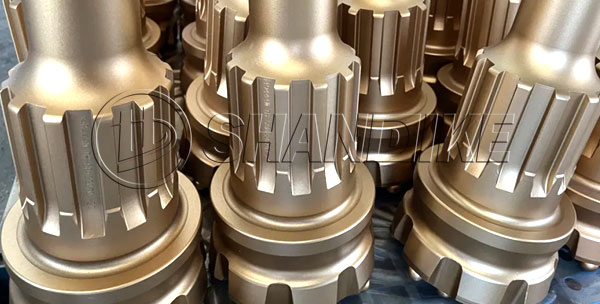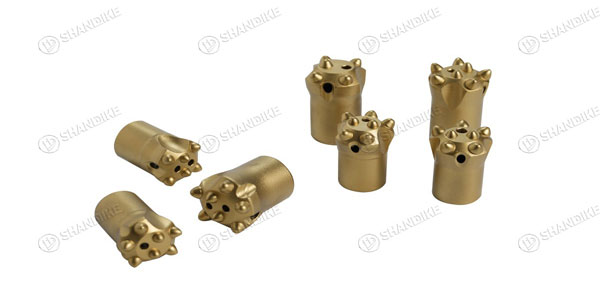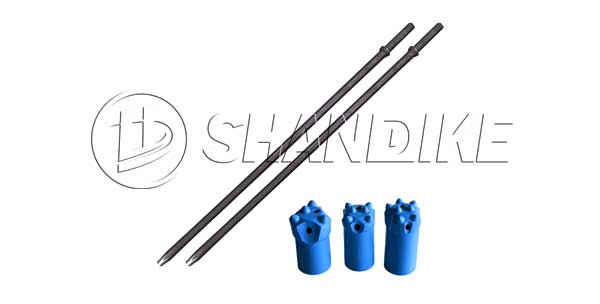How to extend the service life of a DTH button bit?
To maximize the service life of your down-the-hole drill bits, consider implementing these comprehensive strategies:

Material Selection and Quality Assurance:
High-Quality Materials: Select drill bits crafted from superior materials known for their exceptional wear resistance, high-temperature tolerance, and durability. High-grade alloys and specialized composites often yield superior performance.
Coatings: Opt for drill bits with premium coatings that bolster wear resistance, corrosion resistance, and thermal stability, thereby prolonging their lifespan.
Design and Geometry Optimization:
Optimal Design: Ensure that the drill bit boasts a well-thought-out geometry tailored to the specific drilling application. A thoughtfully designed drill bit head and cutting edges can mitigate wear and enhance efficiency.
Geometry Maintenance: Regularly inspect and maintain the drill bit’s geometry. Sharpen worn-out edges or replace them as needed to maintain peak cutting performance.
Operating Parameters and Conditions:
Reasonable Operating Parameters: Fine-tune drilling parameters such as spindle speed, feed rate, and drilling pressure to optimize the drilling process. Avoid excessively high speeds and pressures that can lead to premature wear.
Cooling and Lubrication: Employ cooling lubricants to keep the drilling area cool, minimize friction, and ward off thermal wear. This aids in preserving the drill bit’s sharpness and extends its life.
Drilling Environment: Be mindful of the material being drilled and its properties, including hardness and abrasiveness. Choose the appropriate drill bit and adjust drilling parameters accordingly to align with the material’s characteristics.

Maintenance and Management:
Regular Inspections: Conduct thorough inspections of the drill bit for signs of wear, cracks, or damage. Promptly replace worn-out bits to forestall further degradation and ensure efficient drilling.
Storage Conditions: Store drill bits in a dry, rust-free environment to prevent corrosion and deterioration.
Professional Training: Provide operators with training on the proper use and maintenance of drill bits. Proper handling and operation can drastically reduce abnormal wear and extend the bit’s life.
Specific Considerations for Diamond Bits:
For diamond bits, additional factors to consider include:
Diamond Quality: The grade, size, and concentration of diamonds in the bit impact its lifespan. Choose bits with diamonds that are well-suited for the intended drilling application.
Matrix Composition: The matrix material and its properties are crucial in supporting the diamonds and ensuring they are effectively exposed for cutting. Optimize the matrix composition to match the drilling conditions and material being drilled.
Manufacturing Process: The manufacturing process, including sintering and brazing techniques, can affect the bit’s durability. Ensure high-quality manufacturing to minimize defects and enhance performance.
Pre-Shipping Checklist:
Ensure the drill bit does not come into contact with the metal surface, especially avoiding the bottom of the alloy buttons touching each other.
Carefully inspect the drill bit before shipping and jot down the drill bit number and serial number for future reference.
Foot Valve Maintenance:
Verify the correct installation of the foot valve and its proper exposed height. Ensure the foot valve is intact.
Inspect for damaged and corroded impact ends, typically due to inadequate lubrication. A cracked impact tip often stems from severe wear of the piston, circlip, or bottom bushing.
DTH Button Bit Maintenance:
Drill Bit Head Maintenance:
In highly abrasive formations, the drill body wears down faster than the alloy buttons, a phenomenon known as “drill erosion.” To minimize alloy button breakage, grind them so they are no higher than 9 mm from the drill bit surface.
Control the depth of the chip removal groove due to abrasiveness and wear on the body caused by high drilling speeds. Frequently regrind the flutes to ensure effective debris removal.
Severe erosion and the force of the piston hitting the drill bit can cause alloy buttons to fall off, known as “button loss.” This can occur even with minor erosion. When drilling into soft formations, frequently remove the drill bit for cleaning to maintain constant contact between the drill bit surface and the bottom rock.
Increasing the rotation speed does not necessarily boost the penetration rate but rather increases the wear frequency, particularly in abrasive layers. Under abrasive conditions, control the wear frequency based on the required drilling depth.
A flattened surface button typically indicates a lack of flow energy from the hammer or insufficient torque. Inspect the drill bit for minute cracks at the bottom. Failure to address this condition can lead to surface chipping and ultimately complete failure of the bottom.



